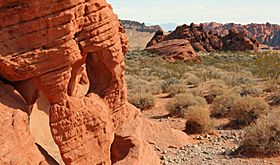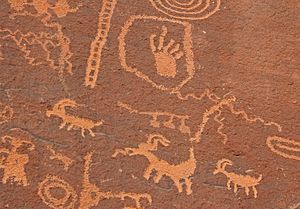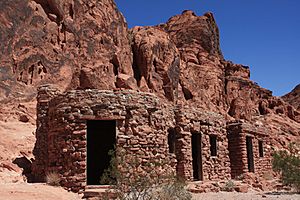Valley of Fire State Park facts for kids
Quick facts for kids Valley of Fire State Park |
|
|---|---|
 |
|
| Lua error in Module:Location_map at line 420: attempt to index field 'wikibase' (a nil value). | |
| Location | Clark County, Nevada, United States |
| Nearest city | Las Vegas, Nevada |
| Area | 45,937.88 acres (18,590.40 ha) |
| Elevation | 1,581 ft (482 m) |
| Established | 1935 |
| Administered by | Nevada Division of State Parks |
| Visitors | 174,533 vehicles (in 2017) |
| Designation | Nevada state park |
| Designated: | 1968 |
| Reference #: | 150 |
Valley of Fire State Park is a special place for outdoor fun and nature. It covers almost 46,000 acres in Nevada, about 16 miles south of Overton. This park gets its name from amazing red rock formations. These rocks are made of sandstone that formed from ancient sand dunes 150 million years ago. When the sun shines on them, they often look like they are on fire!
Valley of Fire is Nevada's oldest state park. It was officially recognized in 1935. In 1968, it was also named a National Natural Landmark. The park is located in the Mojave Desert, about 50 miles northeast of Las Vegas. Its elevation ranges from about 1,320 to 3,009 feet.
Contents
How the Valley of Fire Rocks Formed

The amazing landscape you see at Valley of Fire was created by Earth's movements and then shaped by wind and water over millions of years. The park's rugged ground and tall, jagged walls are full of bright red rock formations. These rocks are made of eroded sandstone and sand dunes that are more than 150 million years old. Other types of rocks found here include limestones and shales.
Who Lived in Valley of Fire Long Ago?

Long, long ago, people lived in the Valley of Fire. These early inhabitants were called the Ancestral Puebloans, also known as the Anasazi. They were farmers who lived in the nearby fertile Moapa Valley. They visited the Valley of Fire from about 300 BC to 1150 AD.
They likely came to the park to hunt animals, gather food, and hold religious ceremonies. There wasn't much water, so they probably didn't stay for very long periods. You can still see amazing examples of rock art, called petroglyphs, that these ancient people left behind at different spots in the park.
The idea for Valley of Fire State Park started in 1931. The Civilian Conservation Corps (CCC) began working on the park in 1933. These workers built campgrounds, hiking trails, stone visitor cabins, and roads. The park first opened in 1934 and became an official state park in 1935.
What is the Weather Like?
The Valley of Fire State Park has a very dry and warm climate. This is typical for the Mojave Desert.
- Winters: Winters are mild. Daytime temperatures are usually between 54°F and 75°F. Nights are cooler, from the mid-30s to low 50s°F (3-12°C). Sometimes, storms from the Pacific Ocean bring rain in winter.
- Summers: Summers are very hot! Daily high temperatures are usually between 100°F and 115°F. They can even reach close to 120°F sometimes. Thunderstorms can bring heavy rain during the summer monsoon season.
The park gets about 6.5 inches (165.1 mm) of rain each year.
| Climate data for Valley of Fire State Park, Nevada (1991–2020 normals, extremes 1972–present) | |||||||||||||
|---|---|---|---|---|---|---|---|---|---|---|---|---|---|
| Month | Jan | Feb | Mar | Apr | May | Jun | Jul | Aug | Sep | Oct | Nov | Dec | Year |
| Record high °F (°C) | 75 (24) |
87 (31) |
96 (36) |
100 (38) |
111 (44) |
118 (48) |
120 (49) |
116 (47) |
114 (46) |
102 (39) |
87 (31) |
80 (27) |
120 (49) |
| Mean daily maximum °F (°C) | 58.2 (14.6) |
62.7 (17.1) |
70.9 (21.6) |
79.1 (26.2) |
89.2 (31.8) |
100.2 (37.9) |
105.3 (40.7) |
103.6 (39.8) |
96.4 (35.8) |
82.5 (28.1) |
68.0 (20.0) |
57.0 (13.9) |
81.1 (27.3) |
| Daily mean °F (°C) | 49.2 (9.6) |
53.2 (11.8) |
60.3 (15.7) |
67.5 (19.7) |
77.2 (25.1) |
87.9 (31.1) |
93.7 (34.3) |
92.0 (33.3) |
84.4 (29.1) |
71.2 (21.8) |
57.9 (14.4) |
48.1 (8.9) |
70.2 (21.2) |
| Mean daily minimum °F (°C) | 40.1 (4.5) |
43.7 (6.5) |
49.8 (9.9) |
55.9 (13.3) |
65.2 (18.4) |
75.7 (24.3) |
82.1 (27.8) |
80.3 (26.8) |
72.5 (22.5) |
60.0 (15.6) |
47.7 (8.7) |
39.3 (4.1) |
59.4 (15.2) |
| Record low °F (°C) | 19 (−7) |
18 (−8) |
29 (−2) |
29 (−2) |
42 (6) |
48 (9) |
64 (18) |
61 (16) |
49 (9) |
38 (3) |
28 (−2) |
12 (−11) |
12 (−11) |
| Average precipitation inches (mm) | 0.78 (20) |
1.12 (28) |
0.76 (19) |
0.31 (7.9) |
0.18 (4.6) |
0.06 (1.5) |
0.68 (17) |
0.37 (9.4) |
0.28 (7.1) |
0.42 (11) |
0.52 (13) |
0.81 (21) |
6.29 (160) |
| Average snowfall inches (cm) | 0.0 (0.0) |
0.0 (0.0) |
0.0 (0.0) |
0.0 (0.0) |
0.0 (0.0) |
0.0 (0.0) |
0.0 (0.0) |
0.0 (0.0) |
0.0 (0.0) |
0.0 (0.0) |
0.0 (0.0) |
0.3 (0.76) |
0.3 (0.76) |
| Average precipitation days (≥ 0.01 in) | 3.5 | 4.2 | 3.7 | 1.9 | 1.1 | 0.6 | 2.1 | 2.1 | 1.6 | 2.2 | 2.0 | 3.5 | 28.5 |
| Average snowy days (≥ 0.1 in) | 0.0 | 0.1 | 0.0 | 0.0 | 0.0 | 0.0 | 0.0 | 0.0 | 0.0 | 0.0 | 0.1 | 0.1 | 0.3 |
| Source: NOAA | |||||||||||||
Exploring Valley of Fire Road
Valley of Fire Road is the main road that goes through the park. This 10.5-mile section of the road was named a Nevada Scenic Byway in 1995. It's a beautiful drive with amazing views of the red rocks.
Fun Things to Do and See
The park has a visitors center where you can learn more. There are also places for picnics, camping, and hiking. You can see petroglyphs (ancient rock carvings) all over the park. Two easy-to-reach spots with many petroglyphs are Mouse's Tank and Atlatl Rock. The park also keeps three stone cabins that were built by the Civilian Conservation Corps workers.
Valley of Fire in Movies
Valley of Fire is a popular spot for filming movies and commercials. Its unique landscape makes it look like another planet or a wild, untamed place. Here are some movies and TV shows that were filmed here:
- Viva Las Vegas (1963): Scenes with Elvis Presley were filmed here.
- The Professionals (1966): This movie with Burt Lancaster and Lee Marvin used Valley of Fire as one of its main locations. You can still see a small part of a rock wall from a movie set.
- Total Recall (1990): Most of the outdoor scenes that looked like the planet Mars were filmed in Valley of Fire.
- Star Trek Generations (1994): The Silica Dome in the park was used as the planet Veridian III. This is a famous spot for Star Trek fans because it's where Captain James T. Kirk's character passed away.
See also
 In Spanish: Parque estatal Valle del Fuego para niños
In Spanish: Parque estatal Valle del Fuego para niños



